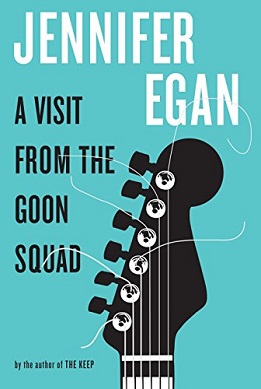I read Jennifer Egan’s A Visit From the Goon Squad about a year ago, a collection of loosely tied short stories that won the Pullitzer Prize in 2011. The construction of this book is similar to Tom Rachman’s The Imperfectionists, which I reviewed a few months ago, but this one has even less of a connecting factor between stories (Rachman’s novel was tied together by an English-language newspaper based in Rome). Most of the stories can be read as stand-alone, and each does feature a different character, but the fact that they exist side-by-side in the same collection makes it possible to search for connection and frequently find it.
Many of the stories have been published before in both literary journals and edited collections, and when I read “Selling the General” in this collection I realized that I had read it before, in a collection called This is Not Chick Lit edited by Elizabeth Merrick, when I was working at a secondhand bookstore. After that I read every story with a sort of anticipation, an “is-this-the-second-time-reading-this-or-the-first?”
There is one story in the collection that I knew overwhelmingly that I hadn’t read before, “Great Rock and Roll Pauses by Alison Blake.” It’s one of the stories highlighted in every review of A Visit From the Goon Squad that I’ve read, because writing an entire chapter/short story in PowerPoint is pretty noticeable. The slides are printed page to page, with a mixture of Venn diagrams, flow charts, and arrows constructing narratives. There is something about the limited structure, the fitting of story into small boxes and circles that makes this the most affecting chapter of the book. Egan chooses her words carefully, and this lends a lyrical, poetic quality to the story.
All of this is doubled by the subject matter of this story, about a boy trying to communicate with his father through the pauses in rock and roll songs. Alison, the narrator of the story (which she records in her “slide journal”), has a brother named Lincoln, who notes the length of the pauses in songs and then maps them with his comments. Two songs and his comments:
“Foxey Lady,” by Jimi Hendrix
“Another great early pause: 2 seconds long, coming 2:23 seconds into a 3:19-minute-long song. But this one isn’t total silence; we can hear Jimi breathing in the background.”
“Young Americans,” by David Bowie
“This is a lost opportunity. Hell, it would’ve been so easy to draw out the pause after ‘…break down and cry…’ to a full second, or 2, or even 3, but Bowie must’ve chickened out for some reason.”
He loops the pauses sometimes, leaving big spaces of silence in the house. His dad doesn’t understand and gets frustrated with Lincoln’s obsession with pauses, and when he loses his temper with Lincoln, his wife says very carefully, “The pause makes you think the song will end. And then the song isn’t over, so you’re relieved. But then the song does actually end, because every song ends, obviously, and THAT. TIME. THE. END. IS. FOR. REAL.”
And all of that is floating in bubbles and shapes and arrows against the outline of a PowerPoint slide. It’s all of this emotion pressurized and compacted and made small.
“Great Rock and Roll Pauses by Alison Blake” is only one of the stories in this collection that has been picked up for adaptation by HBO. It is a collection worth reading, especially for this chapter.







